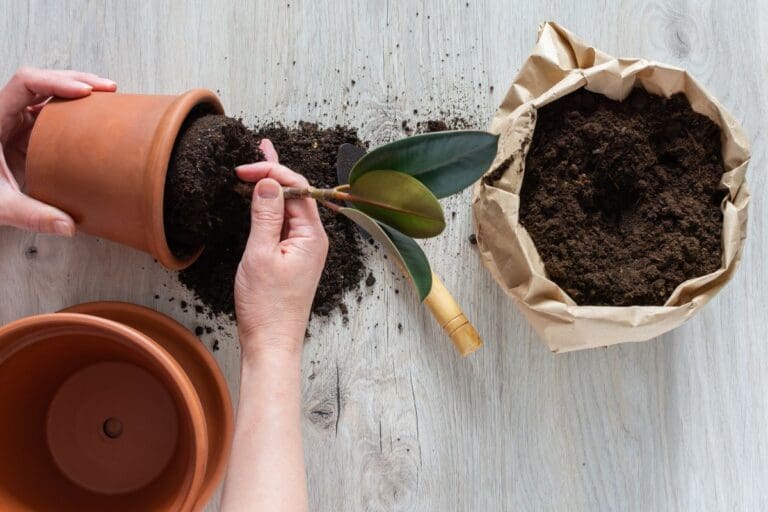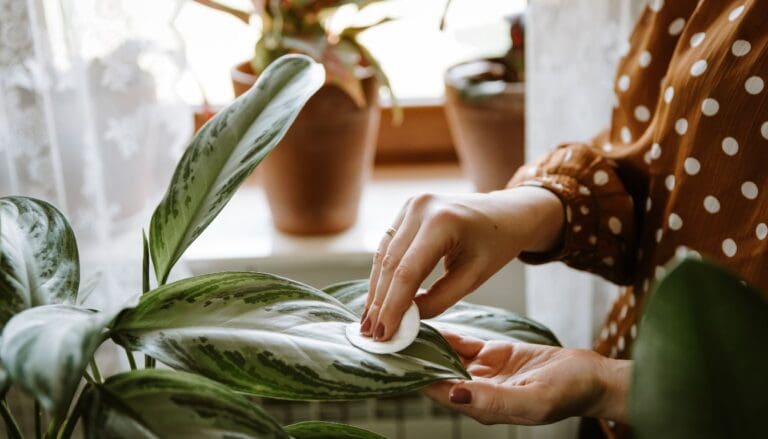Why Is My Boston Fern Drying Out? (Causes+How To Fix)
Boston ferns have come a long way as houseplants are an obvious choice of plant owners to uplift the beauty of any dull corner. But, the drying out of the fern leaves is one of the most common problems that bother the plant.
The Boston ferns can dry out due to underwatering, low humidity levels, too much sunlight, and incorrect fertilization. To prevent the problem of drying out in Boston fern, you must ensure your fern gets the right amount of water, humidity, fertilizers, and lighting.
In this article, I will discuss the various reasons behind drying your Boston ferns and the steps you can take to prevent and cure this problem. Keep on reading to know more.

Please note: Simplify Plants is reader-supported. Some links in the post are affiliate links and I get a commission from purchases made through links in the post.
What are the signs that my Boston fern leaves are drying?
Boston ferns face a common problem drying out the fronds, making them yellow, brown, and weak.
There are multiple reasons behind this problem.
They are mostly easy to cure once you know what to do to prevent this.
It is important to examine the signs and understand the reason behind the problem.
Some of the most common signs of Boston ferns drying are:
- Brown leaves
- Dry crispy fronds
- Leaves curling with brown edges
- Leaves turning yellow and brown and dropping the leaves
- Slower growth rate
- Dehydrated cracked soil surface without moisture
- Decrease in the growth rate and sizes of new leaves
These are some of the common signs of dried Boston fern.
There are multiple reasons behind the Boston fern showing these symptoms.
Let us now learn about the various causes that lead to the fronds of your Boston fern drying up.
Why my Boston fern leaves are drying?

Leaves of plants drying up are a sign of stress that the plant is exposed to unsuitable growing conditions.
It happens due to dehydration, low humidity, overfertilization, extreme temperature changes, etc.
Let us now understand how these problems affect the health of Boston ferns and make the fronds go dry.
Low humidity
One of the biggest obstacles in growing ferns indoors is the lack of humidity.
Boston ferns require above 80% humidity to thrive.
Humidity is one of the vital requirements of the ferns and is one of the leading causes of drying up of the leaves.
The dried and brown leaves cannot be reversed, so there is no way to make them green again apart from clipping off those leaves and branches.
The best and only solution to this is to increase the area’s humidity and make the surrounding area humid with the help of artificial measures to raise humidity.
Also read: Should I Mist My Boston Fern? (How Often+Pros & Cons)
Incorrect watering

One mistake that Boston fern owners commonly make is overwatering or underwatering them.
This process severely affects the health of your ferns.
The health and green color of the fronds depends on the watering level.
If the fern does not have sufficient water and moisture in its roots, it will get dehydrated and yellow.
Dry soil can cause wilting and eventually drying out, while extremely soggy soil makes the leaves yellow and leads to root rot.
Boston ferns require evenly moist soil constantly, without being soggy or bone dry.
Also read: How To Water Boston Fern? (How Often, How Much & More)
Sunburn
Another common reason that dries up your ferns is sunburn.
Your Boston ferns, in nature, grow under the large tree canopy that gives it shade and coolness from the sun’s direct rays.
If your Boston fern gets exposed to direct sunlight, it might lead to sunburn that will turn the fronds dry and yellow.
The two major reasons for sunburns are:
- Prolonged exposure to hot scorching sun in summer: Boston ferns cannot tolerate direct sun rays falling on them, damaging the fronds. It burns and dehydrates the leaves by increasing the transpiration rate leading to dry ferns.
- Buying plants from a nursery and bringing them indoors: When the plant grows in a nursery gets a different light exposure. So when we bring the plant to our homes, the light exposure abruptly changes. This can lead to sunburns on the leaves.
Also read: Boston Fern Sunburn: Signs, Causes & How To Fix
Unfavorable environmental changes

Boston ferns cannot tolerate drastic temperature changes.
Their ideal temperature is between 60-75ºF.
It is intolerant to frost or very high temperatures.
It pushes the plant into shock and stress, caused when the plant cannot deal with the surrounding condition.
Also, if you frequently move your ferns from one place to another, it will lead to temperature changes that can harm the plant.
If you want to move your fern outdoors from indoors, you have to gradually make the fern used to the new environment.
Do not bring sudden and abrupt changes to the fern, which are bound to harm it.
Also read: Boston Fern Temperature Tolerance: +Ideal Temperature
Excess fertilizer
Fertilizing your Boston fern from time to time is important to give it the necessary nutrients that the plant cannot get otherwise because houseplants in a pot are confined to limited nutrition that is available to them.
However, over-fertilization can be equally and sometimes even more harmful to your ferns.
Boston ferns are light feeders, and putting too much fertilizer can burn the leaves and the roots of the plant and cause it to turn brown and dry out.
Also read: Should I Fertilize My Boston Fern? (Ideal Fertilizer+When & How Much)
How do you revive a dried Boston fern?

I have explained the various causes that can dry out your Boston fern.
It is most important to find out the cause of the concern.
Only then can you take the necessary actions to prevent the dryness of the fern in the future.
Boston ferns are hardy, and it is possible to revive them back if you correct the conditions for the plant.
Now we will discuss the ways you must follow to cure this problem and treat this problem with the help of correct care measures.
Reviving a Boston fern drying due to low humidity
Boston ferns are a sucker for high humidity, and it is necessary to push out that long green, healthy fronds.
If you happen to live in those areas where there is low humidity and the air is dry, it is bound to impact the health of your Boston fern.
Your fern will turn yellow and dry and feeble.
To prevent this problem, you have to use artificial ways to increase humidity.
If you wonder how to do that, do not panic.
Here we list down various ways which you can use to increase the humidity around your plant.
Pebble tray
Using pebble trays is a common way of increasing the humidity around the Boston fern or any moisture-loving houseplant.
- You need to take a shallow tray and fill it with a layer of pebbles.
- Then, pour water into the tray and fill it until all the rocks are moist and submerged.
- Now place the plant on the pebbles.
- Be careful to notice that the bottom of the pot does not directly touch the water because that might lead to root rot issues.
- As the water from the tray evaporates, the moisture level will increase around the plant.
- Refill the plate as and when needed.
Humidifier

Humidifiers are probably the most long-lasting among all the techniques to increase humidity.
Fill it with rainwater or distilled water and place the humidifier around the moisture-loving ferns like Boston ferns, and the moisture level will be up in no time.
A humidifier lets you control the humidity level and increases and decreases it as per requirement.
Grouping your plants
This is another technique t increase humidity around your plants which is also very similar to their native state.
Like in forests, the plants grow in groups the same way you group the plants.
This way lets them give off humidity to one another by the process of transpiration and create an environment of vapor transaction for each other.
Misting

The most technique followed to increase moisture in the plants is misting.
This is a simple and easy way, but it is short-lived.
Its results are temporary as the water gets evaporated quickly.
How frequently you should mist your plant depends on the weather and the temperature of your region.
Sometimes on extremely hot summer days, you might have to mist your fern multiple times per day, and in cooler regions or rainier areas, you might skip misting and do it every 3-4 days.
Changing the area where it is kept
You can shift the fern to a damp, humid area of your house like the kitchen, bathroom, or laundry room provided it gets a lot of light and air.
Reviving a Boston fern drying due to underwatering
Your Boston fern requires soil that is evenly moist at all times.
The soil should not be extremely soggy or dry.
If you find it difficult to understand when to water the plant, dip your finger in the soil to check the moisture.
If the soil sticks to your finger, do not water, and if it does not stick to your finger, water it.
When you see the soil is around 25% dry, you should water it.
You can use a moisture meter for the same.
If you feel your fern is going through the stress of minor watering, you can solve it with a regular watering pattern.
Ensure to water until you see it running out of the drainage holes.
- Trim off the dry yellow leaves so that the plant can utilize energy and grow newer leaves.
- One way to give moisture to the dehydrated fern is by soaking the pot in a bucket of water for 15-30 minutes.
- If you haven’t watered your fern for quite some time, aerate the soil by poking holes into the soil with a chopstick. You should water it thoroughly until the excess water runs out. This way, the roots get the water.
Reviving a Boston fern drying due to sunburn

Most Boston ferns get sunburned in extreme light or direct sunlight because they prefer shade.
In nature, they grow under the shades of large trees, so they cannot tolerate direct sun rays.
You cannot revive the burned and dried leaves, so you must trim them off.
However, you can take necessary measures to prevent further drying of the ferns.
- Place the Boston fern near a bright north-facing window in summers and an east-facing window in winters.
- If you place it near a south-facing window, keep it outside the direct sun rays or use a sheer curtain between the sunlight and the plant.
- You can hang them on the porch or patios with a shade or plant them under big trees.
Reviving a Boston fern drying due to climatic changes
Protect your fern from high heat and frost because they are sensitive to extreme climates.
- If your Boston fern is kept outdoors in harsh cold weather, you must bring it indoors, and if they are indoors, try keeping them away from windows, doors, etc., to protect them from the cold.
- Sometimes people keep their plants near fireplaces or heaters in winter to give warmth to the plant. You should not do it as it can cause the plant to dry up.
- Give the fern 2-3 hours of early morning mild sunlight in winters to give it some warmth.
- Also, you must keep the Boston fern away from all the cold drafts, vents, and air conditioners which also suck up the humidity from the plant.
- Refrain from fertilizing during the winter months as its growth rate is very low. Fertilizing during this period can drain the plant of its necessary nutrients.
Reviving dry Boston fern caused by overfertilization

Fertilizers provide the plants with the nitrogen, phosphorous, and potassium necessary to grow.
However, Boston ferns being light feeders, run the risk of overfertilization.
So fertilizing them too frequently or too much can harm the fern.
Fertilize the ferns in the growing season around spring and before fall with slow-releasing fertilizers like compost or water-soluble fertilizer like NPK 20-10-20.
Dilute the fertilizer to avoid overfertilization.
Do not fertilize the rest of the year and let it rest.
If you think your fern has been overfertilized, you must change the soil mix.
Take a new pot, prepare a fresh soil with 1 part soil, 1 part perlite, and 1 part coco peat, and plant the fern.
Before repotting, trim off the dead and damaged roots and wash them under running water.
Final words
As mentioned above, drying up ferns is a common problem, but you need not fret over it. I have discussed the various causes that lead to the drying up of the ferns when the condition is not correct for the plant’s growth.
If you notice any yellowing and drying of the fronds, you must not ignore it and examine it well to find out the problem. The already dried fronds cannot be revived, and you can prevent further drying up.
Once you find the problem, you can take possible preventive measures to cure and prevent the problem in the future so that your fern continues to grow gracefully with its bushy long green fronds.
Reference: University of Florida, The University of Arkansas Division, Texas A&M University System, The University of Georgia, University of New Hampshire, Wikipedia, The Royal Horticultural Society.
Recommended Garden Supplies
| Product Image | Our Recommended Gardening Supplies | Check Offers! |
|---|---|---|
Top Top
Top
Top
Top
Top
Top
Top
Top | rePotme Houseplant and Tropical Classic Potting Soil Mix | Check Offer On Amazon |
 Top
Top
Top
Top
Top
Top
Top
Top | Espoma Organic Indoor Plant Food | Check Offer On Amazon |
 Top
Top
Top
Top
Top
Top
Top
Top | GooingTop LED Grow Light 6000K Full Spectrum Clip Plant Growing Lamp | Check Offer On Amazon |
 Top
Top
Top
Top
Top
Top
Top
Top | Soil Moisture Meter | Check Offer On Amazon |
 Top
Top
Top
Top
Top
Top
Top
Top | Govee Hygrometer Thermometer, Bluetooth Enabled! | Check Offer On Amazon |
 Top
Top | LEVOIT Humidifiers for Large Room(Best For Plants) | Check Offer On Amazon |
 Top
Top
Top
Top
Top
Top
Top
Top | Upgraded DIY Automatic Drip Irrigation Kit, 15 Potted Houseplants Support | Check Offer On Amazon |
 Top
Top
Top
Top
Top
Top
Top
Top | Stainless Steel Heavy Duty Gardening Tool Set | Check Offer On Amazon |
 Top
Top
Top
Top
Top
Top
Top
Top | Bonide Insecticidal Soap | Check Offer On Amazon |
 Top
Top
Top
Top
Top
Top
Top
Top | Bonide 32 oz Spray Neem Oil for Organic Gardening | Check Offer On Amazon |
 Top
Top
Top
Top
Top
Top
Top
Top | Garden Safe Fungicide | Check Offer On Amazon |






